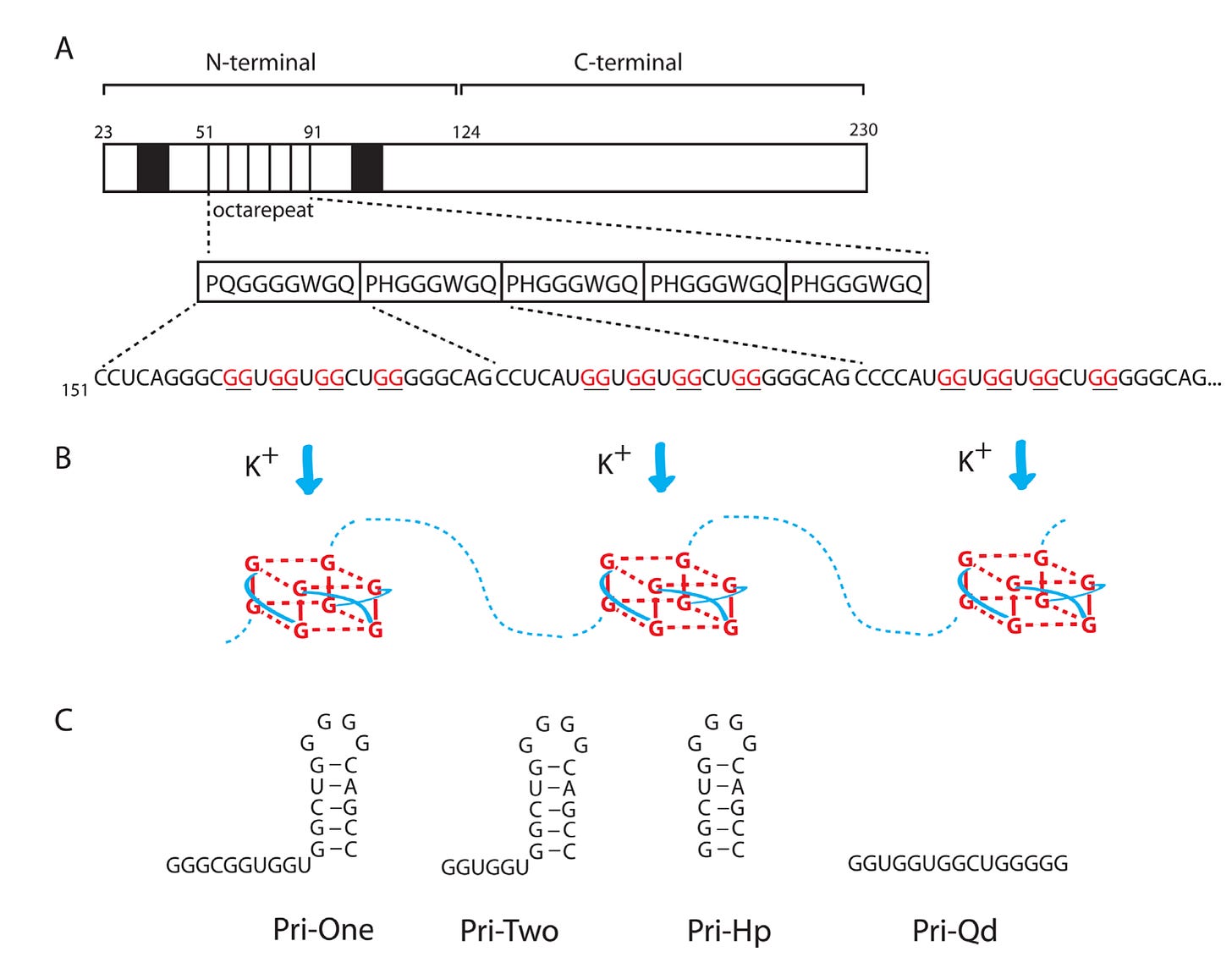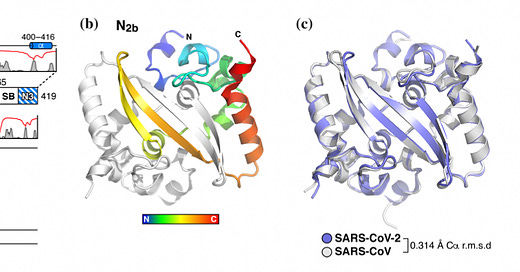Viral SARS-CoV-2 N protein and spike protein may act in concert to promote prion disease during infection, even though spike alone is not a prion-forming protein.
MRNA Covid vaccine RNA, meanwhile, may directly deform human prion protein, due to G-quadraplex enrichment from the rewriting (“optimization”) of the sequence for spike.
Both these potential dangers have, astonishingly, apparently not been researched at all.
This series seeks to address and clarify the influence that SARS-CoV-2 (the virus) or the Covid vaccines might have on prions.
Part 1 took on the question of “what are prions” and the controversy of whether spike protein is prionogenic. Readers are obviously encouraged to read this first, to help distinguish between “prion protein” and “prion” as will be used here.
The following points were covered:
Yes, the big, bad spike protein is amyloidogenic, but the question of whether it induces “prions” is separate, and very specific (as far as our current, limited understanding operates).
It would need to have a 20+ residue, G,N,Q,S,Y-rich region with repeats. It doesn’t. These regions are like the “keys” that unlock the disease form of prion proteins. The Spike protein doesn’t have a key.
The tiny blip in the PLAAC algorithm does not actually define Spike as prionogenic, but rather “prion-like” — an intrinsically misleading, algorithm-programmer-invented term since it can be applied in total disregard of ability to generate prions. The language of humans sometimes defies the language of nature.
An overall theme of Part 1 was that the language of “prions” is imprecise. So to talk about “prions,” we must deconstruct the terminology. There are two different biological phenomena that are believed to “make prions” to which we could potentially turn our interest:
Molecules which, upon contact, can reshape currently healthy prion proteins into misfolded, amyloid state — these naturally include already-misfolded prion proteins, aka “prions,” at least in a lab setting.
Biological elements or processes which, over the long term, can lead to accumulation of amyloid prion protein aggregates (“prions”). This includes anything which promotes these aggregates or diminishes efficient breakdown of prion protein, a highly-recycled and ubiquitously expressed molecule.
Spike fails at 1: It does not have any structures which would directly influence prion protein to adopt disease forms. By pointing this out, I am not making any comment on the 2nd phenomenon. This series does not dispute anyone else’s analysis that suggests spike might be leading to prions via, for example, generic metabolic distress, etc. But neither does such analysis demonstrate that phenomenon 1 is occurring: It doesn’t show that spike is actually “a prion protein,” or prionogenic.
This point is very important as far as evaluating the risk of infection vs. injection. Both have spike protein, but it isn’t prionogenic — but what about the things they don’t both have?
Thus, Part 2’s topics are the Nucleocapsid protein of the virus and the “optimized” RNA of the Covid vaccines.
Prion risk-factor 1: Viral Nucleocapsid protein
As we saw in part 1, the Nucleocapsid protein actually scores high in the PLAAC tool for both the prion algorithm (red text) and the disorder algorithm (black underlined text)

The Nucleocapsid protein does, in fact, contain a region that might be prionogenic. This is the “N-terminal Intrinsically Disordered Region,” (N-IDR) which is followed by the RNA binding region. The overall layout is the same design used in every coronavirus Nucleocapsid: Disordered region, followed by RNA binding region. Here is a picture of two SARS-CoV-2 N proteins hugging it out, color-coded according the the part that is synthesized first (the N-terminal) and last when our ribosomes are churning out virus parts.

Every coronavirus N protein has a disordered, leader “N-IDR” domain, but in no study that I could find has its function been elucidated. Feel free to imagine any purpose you like.1

More important is whether other human coronavirus N protein N-IDR domains also appear prionogenic — as in having Q, N repeats and high G content. Kind of?

Conserved, apparently natural
Your humble author will now speculate whether the N-IDR potential-prion-forming-domain is some secret weapon added to SARS-CoV-2, using eyeball-based phylogenetic analysis.
Pre-Omicron variants, including the first school of Variants of Concern, made no changes to any of the G, Q, or N residues in the N-IDR.2
Because “Omicron” appears not to have originated from human transmission, it potentially illuminates whether the N-IDR domain seeks functional optimums that might be disfavored by immune recognition in human-to-human spread.
The Last Common Ancestor of the Omicron siblings modifies 1 and removes three residues from this domain; this makes it less conserved than other portions of the protein but still conservative overall. No N or Q residues are replaced. These therefore do not seem like truly useless elements; nor does their use seem to involve interaction with the human immune system. It thus seems unlikely that they are “add-ons” resulting from human tinkering; but rather are part of the sensitive interplay between the SARS-CoV-2 N protein and other elements of the replication cycle.
And so if this region is prionogenic, it might not be more-so in vivo than regular human coronavirus N-IDRs. Likewise, it may be comparable to our own, endogenous RNA-binding proteins, many of which have become objects of attention for scoring high in PLAAC.3 It could be that a domain similar to SARS-CoV-2’s N-IDR, and a potential overlap with prion-forming-domains, is intrinsic to protein structures that are good at "binding RNA."
All that could be true, but SARS-CoV-2 could present a special risk for disseminating prionogenic Nucleocapsid via the endothelial disruption caused by the spike protein. It could be that soluble, circulating spike S1 and Nucleocapsid “team up” to dissolve the blood-brain barrier and deposit prionogenic N protein all over the place. Maybe this is important for everything from short and long-term brain fog to reduction in brain volume after infection. It’s a possibility that deserves more research, especially given what seems to be at stake.
Prion risk-factor 2: Vaccine G-Rich mRNA
The human Prion protein can switch from ordered to disordered as a response to other disordered Prion proteins, or to certain conformations (secondary structures) in RNA molecules. Specifically, “G quadraplexes.” To simplify, these form when guanine molecules are next to each other in intervals, like four magnetic links spaced out in a chain.

Note that G corresponds to guanine, the nucleotide, in RNA; and to glycine, the amino acid, in the protein. They aren’t the same, even though the amino acid glycine can actually be spelled with three guanines in a row (spoopy).
In the example above, the RNA molecule that codes for the amino acids appears to contain a series of repeating G4 motifs, each of which would be expected to form a G-quadraplex if this RNA molecule was just swimming around in the cell. G quadraplexes are rare, however, in coding RNA — you don’t want the actual code for your proteins to stick to itself, or how is a ribosome supposed to read it?4 It would be like gluing the pages of a book shut.
Astonishingly, the example above is from the prion-forming-domain of the human Prion protein. However, it is now thought that the RNA molecule takes on a helix structure as opposed to a “string of boxes” as shown.5
That’s a good thing, as it is believed that G-quadraplexes in RNA molecules cause the prion protein to take on diseased form.6
Cellular ribonucleic acid (RNA) plays a crucial role in the initial conversion of cellular prion protein PrPCto infectious PrPSc or scrapie. The nature of this RNA remains elusive. Previously, RNA aptamers against PrPC have been isolated and found to form G-quadruplexes (G4s). PrPC binding to G4 RNAs destabilizes its structure and is thought to trigger its conversion to PrPSc.
Covid-vaccine mRNA is rich in potential G-quadraplexes
The designers of the mRNA transfections elected to “optimize” the code corresponding to the spike protein. Rather than assume, intelligently, that the virus has tuned its spelling choices to favor efficient translation in human cells, the designers assumed, stupidly, that the spelling choices were all junk, and specifically did not have enough guanine. And so if letters could be changed to guanine and still correspond to the same amino acid, they were changed to guanine. The result was a lot of guanine, and a lot of new potential G-quadraplexes. That this remodels the RNA molecule secondary structure and leads to absurd counts of likely G-quadraplexes was pointed out in a paper by Kevin McKernan and colleagues:7

That G4 richness was a danger in regards to prion disease was specifically proposed by J. Bart Classen in early 2021.8 His paper is now credited by wikipedia with having inspired fringe concerns that the Covid vaccines would cause prion disease,9 though as I did not join the fringe until a few months later, I wouldn’t know. As a consequence, the points made by the paper were widely denounced. Critically, Classen associates the G4 risk with different, nuclear proteins, rather than with prion protein itself. And to bring us full circle in this review of the prion controversy, Classen included a reference to Tetz, Tetz's inconsequential PLAAC-results finding (see, again, Part 1). For these reasons, his paper does not hold well against even semi-incompetent fact-checking.10
Classen’s paper thus grazes, but ultimately fails to elucidate a clear, obvious danger that should have demanded an extraordinarily high bar of safety-testing to clear: Covid vaccine G-quadraplexes may interact with simultaneously expressed prion proteins inside of cells.
Or may not.
We don’t know.
Known/unknown
Even if G4s plus prion protein are only a hypothetical, algorithm-based risk, related to a still poorly-understood element of neurological disease — what possible sense is there in taking that risk 19 separate times, as in the Moderna sequence?
No explanation seems adequate except that the designers were ignorant of secondary structure considerations altogether, or malicious. The latter hypothetical is difficult to parse — G4 enrichment may cause the Covid vaccine mRNA to deform prion proteins, but it may also impede efficient translation of spike protein by ribosomes.
On the other hand, it may also help sequester RNA in cells and delay degradation by proteases.11 In this case there could be a synergistic effect, where G4s prolong spike expression and deform healthy prion proteins on their way to the cell membrane.
From that starting point, there are any number of additional pathogenic effects that Covid vaccine G4 “boxes” may exert. Of those reviewed in this table, which focuses on neurological diseases, some may depend on mRNA making it into nerve cells specifically or into the nucleus, which is a separate debate.12 Others may be generic.

These may only be the tip of the iceberg, of course. As a model for a more widespread harm, for example, imagine that Covid vaccine G4 “boxes” simply bind proteins that have better things to do in general. G-quadraplexes are central elements of gene regulation in eukaryotes (like us); part of this regulation depends on proteins that recognize and bind G4, oftentimes to suppress certain genes. If Covid vaccine RNA competes for these proteins, gene expression can go amok. This could be synergistic or redundant with epigenetic changes resulting from rampant spike expression sustained by the use of pseudo-uridine to avoid degradation. It all seems a self-evident cancer risk.
Overall, we know close to nothing about the effect that cramming transfection mRNA so full of G4s will have on cellular metabolism and protein homeostasis. This, alone, is reason enough not to have played God with the sequence for spike.
If you derived value from this post, please drop a few coins in your fact-barista’s tip jar.
It may simply serve to camouflage less conserved epitopes in the RNA binding domain (however, this seems unlikely given the analysis in “Conserved, apparently natural”). It may interact with other viral proteins during virus assembly. It may be structurally essential for RNA packing despite not binding to RNA directly.
King, OD. Gitler, AD. Shorter, J. (2012.) “The tip of the iceberg: RNA-binding proteins with prion-like domains in neurodegenerative disease.” Brain Res. 2012 Jun 26; 1462: 61–80.
Wang, E. et al. (2021.) “G-Quadruplexes as pathogenic drivers in neurodegenerative disorders.” Nucleic Acids Res. 2021 May 21; 49(9): 4816–4830.
Czech, A. et al. (2019.) “Octa-repeat domain of the mammalian prion protein mRNA forms stable A-helical hairpin structure rather than G-quadruplexes.” Sci Rep. 2019 Feb 21;9(1):2465.
Olsthoorn, R. (2014.) “G-quadruplexes within prion mRNA: the missing link in prion disease?” Nucleic Acids Res. 2014 Aug 18; 42(14): 9327–9333.
McKernan, K. Kyriakopoulos, AM. McCullough, PA. (2021). “Differences in Vaccine and SARS-CoV-2 Replication Derived mRNA: Implications for Cell Biology and Future Disease.” osf.io
Classen, JB. “COVID-19 RNA Based Vaccines and the Risk of Prion Disease.” Microbiol Infect Dis. 2021; 5(1): 1-3. (pdf)
Gorski really flounders on this one, thrashing out in every direction possible to pad his analysis of a topic that is clearly over his head. “Here’s a Bill Maher anecdote; here’s the CDC definition of, what was it again, primons?”
Gorski, David. “Can mRNA-based COVID-19 vaccines cause prion disease or Alzheimer’s?” (2021, February 22.) Science Based Medicine.
In a possibility highlighted by Stephanie Seneff and colleagues, transfected spleen cells may re-cycle vaccine mRNA into exosomes, which then can access the brain via the vagus nerve:
We hypothesize that exosomes released from immune cells in the spleen travel up the vagus nerve to reach the brain stem nuclei, and they deliver their toxic cargo, which can include not only the spike protein but also intact mRNA molecules that encode the protein, to recipient cells in the brain."
Seneff, S. Kyriakopoulos, AM. Nigh, G. McCullough, PA. “SARS-CoV-2 Spike Protein in the Pathogenesis of Prion-like Diseases.” Authorea. August 16, 2022.









Why would they research it? They’ll just tell everyone it’s “long COVID”. The great mass of NPCs are totally used to that explanation for pretty much everything.
Thanks for all of your research as usual!
Stepping back to the 10,000 foot level: Prion protein is a very small target (considering that prion disease is extremely rare and has not been - to our knowledge - triggered by any of the novel proteins or complex biomolecules to which we have exposed ourselves over the past century, nor does it have any known natural triggers except for misfolded prion proteins from humans and closely-related species), and the virus and vaccine are a rather small gun (with respect to the *number* of novel molecules being introduced into the body).
This makes me *extremely* skeptical of any claims that any of this business will cause prion disease, at least by your mechanism #1 of direct molecular interactions leading to misfolding.
There are hundreds of specific mechanisms by which novel mRNA vaccines could cause immune dysfunction, perhaps thousands of potential molecular interactions by which they could be carcinogenic, quite a few mechanisms by which they could trigger amyloid formation, and comparably very few ways in which they could specifically induce human prion protein to take on a pathogenic conformation.
My own version of Occam's Razor says that if these shots fail in the sense of really messing up a lot of human bodies, it's much more likely to be in an arena that has an abundance of possible failure modes. My top three, so far, are:
1. Amyloid clotting leading to cardiovascular consequences and effectively to premature aging of the cardiovascular system. As this appears to be spike-triggered, it occurs in response to both infection and vaccination (although maybe Omicron spike is less amyloidogenic?).
2. Immune dysfunction, largely arising from the confusing self/non-self signals conveyed by a foreign protein expressed by otherwise healthy cells repeatedly and for long periods. This potentially includes tolerance leading to increased covid susceptibility/severity, autoimmunity, immune suppression, and cancer proliferation (although admittedly there are also potential mechanisms of carcinogenicity that don't involve immune disruption).
3. Disruption of the process by which the virus and the collective human immune system reach evolutionary equilibrium, potentially resulting in enhanced rates of immune escape mutations, emergence of more dangerous variants, and more virus deaths than would otherwise have occurred.